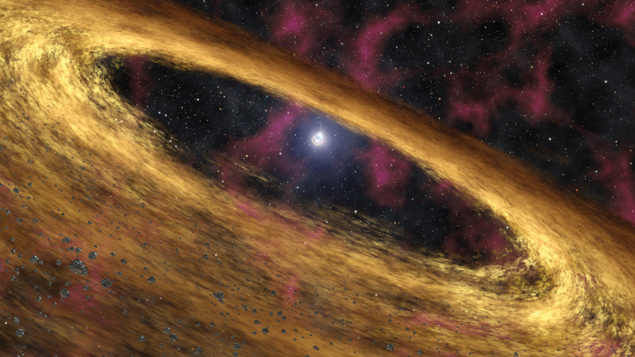
X-ray astronomy has been around for more than 50 years and remains responsible for a wealth of discoveries. Astronomical breakthroughs have been the result of detailed measurements of the X-ray arrival time, direction and energy. But the fourth measurable parameter of X-rays, their polarisation, remains largely unexplored. Following the first rough measurements of a handful of objects in the 1970s by Martin Weisskopf and co-workers, there was a hiatus in X-ray polarimetry due to the complexity of the detection mechanism. In recent years, in parallel with the emergence of gamma-ray polarimetry, interest in the field has returned. Indeed, after some initial measurements using the Chinese–Italian PolarLight Cubesat launched in October 2018, X-ray polarimetry has reached full maturity with the launch of the first large-scale dedicated observatory in December 2021: the Imaging X-ray Polarimetry Explorer (IXPE), a joint project by NASA and the Italian Space Agency, led by Weisskopf.
The IXPE mission uses gas pixel detectors to measure the polarisation for a range of astronomical sources in the 2-8 keV energy range. Incoming X-rays are absorbed in a gas which results in the emission of a photoelectron, the azimuthal emission direction of which is correlated with the polarisation vector of the incoming photon. Tracking the path of the electron therefore allows the polarisation to be inferred. Accurately measuring the emission direction of the low-energy photoelectron, especially in a space-based detector, has been one of the main IXPE challenges and required decades of detector development.
X-ray polarimetry has reached full maturity with the launch of the first large-scale dedicated observatory
IXPE has already observed a range of sources. Its first public results, posted on arXiv on 18 May, concern a magnetar, a highly magnetic neutron star, called 4U 0142+61, which rotates around its axis in about 8 s and has a magnetic field of 1010 T. IXPE’s first ever measurement of polarised emission from a magnetar in the X-ray region shows this extreme object to have an energy-integrated polarisation degree of 12%, while in the thermal (2–4 keV) range this is about 12%, and as high as 41% for emission at higher energies (5.5–8 keV). The polarisation angles of the two emission components are orthogonal.
The results appear to agree best with a model where the thermal emission stems from a condensed iron atmosphere: the higher energy emission would be a result of some thermal photons being up-scattered to higher energies when interacting with charged particles following the magnetic field lines. However, since other models link the emission to a gaseous atmosphere heated by a constant bombardment of particles, measurements of additional magnetars are needed.
Fundamental physics
Apart from providing novel insights into neutron-star properties, time-resolved studies of the emission during the rotation period hints at more fundamental physics at play. The spectral profile of 4U 0142+61 was found to be rather constant during the rotation, indicating that the emission does not come from hot-spots, such as the poles, but rather from a large area on the surface. As the magnetic field over such a large area would, however, be expected to vary significantly, so would the polarisation angle of the emitted X-rays. As a result, the net polarisation seen on Earth would largely be blurred out, resulting in a much lower polarisation degree than is observed.
An intriguing explanation for this, note the authors, is vacuum birefringence – an effect predicted to be important in the presence of extreme magnetic fields, but which has never been observed. While for the magnetar the polarisation angle of the emission varies with the emission location, it gets altered as the photons travel through the strong magnetic field in which continuous electron–positron pairs affect their propagation. Only when the magnetic field is weak enough, at around 100 times the radius of the star, does the polarisation angle get frozen. Since this angle is aligned with the magnetic field, which at this point is smoother, the emission will realign the emission travelling towards Earth and allow for a net polarisation.
Although the polarisation degrees measured by IXPE are not high enough to definitively prove vacuum birefringence, the results give a clear hint. Furthermore, the measurements of 4U 0142+61 are only the first of many performed by the IXPE team. Throughout the coming months, detailed measurements of galactic objects such as the Crab Nebula, as well as extra-galactic sources, are predicted to be released. Among these objects there will be other magnetars, the X-ray emission from which will soon bring further understanding of these extreme objects and potentially confirm the existence of vacuum birefringence.
Further reading
R Taverna et al. 2022 arXiv:2205.08898.








